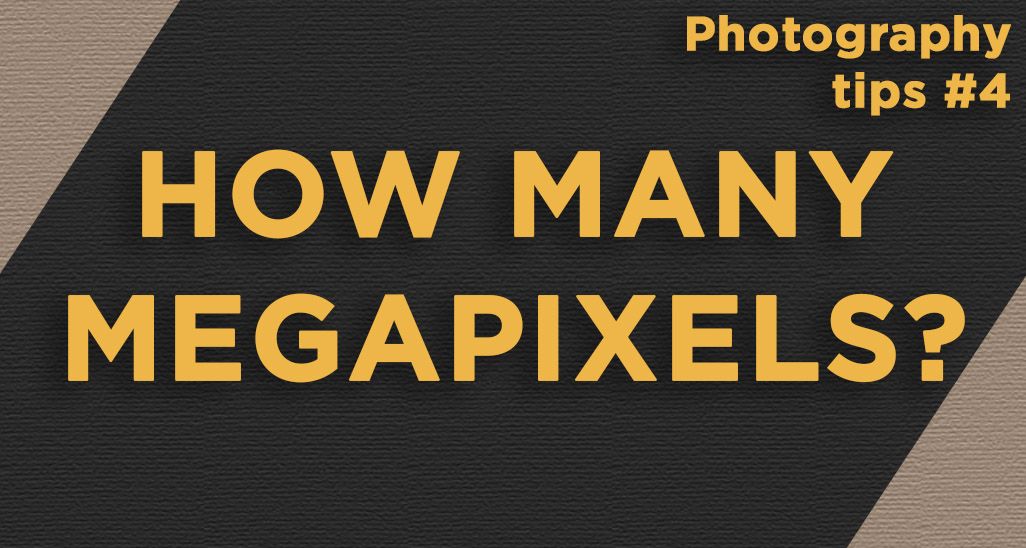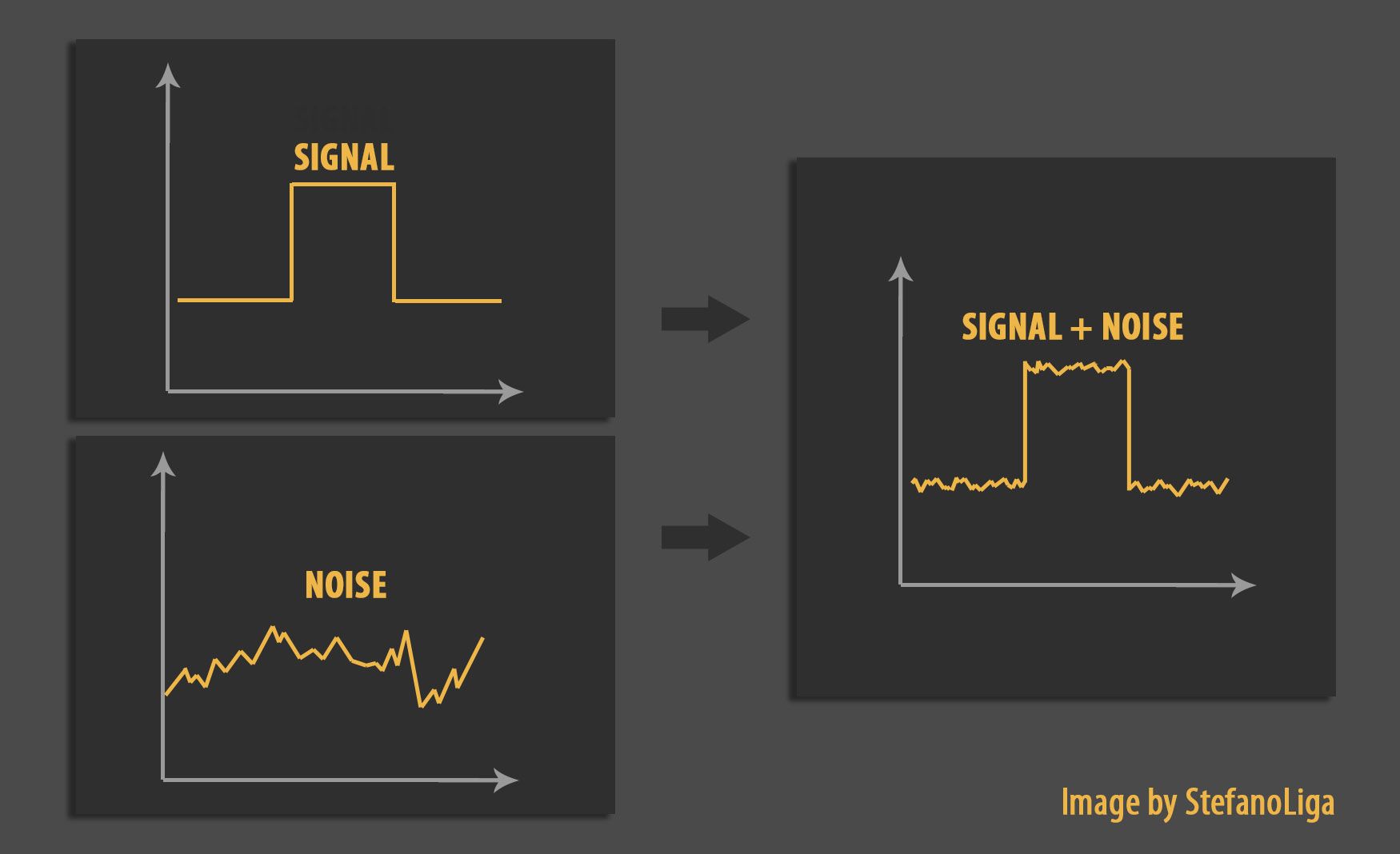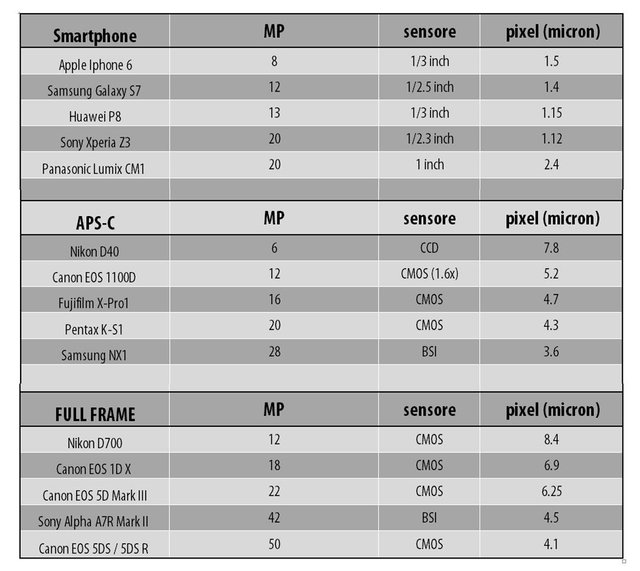PHOTOGRAPHY TIPS #4: How important are MEGAPIXELS? [Importanza dei MP – ITA/ENG]
Immagini originali dell'autore
Original images by the author

La corsa ai megapixel
Esistono in commercio fotocamere con 40 Megapixel e anche più… Ma quanto è importante questo parametro? Quanti ce ne servono veramente? Con questo articolo cercherò di farti capire come sia inutile investire una fortuna per avere più Megapixel (piuttosto investi il tuo denaro in obiettivi di qualità!)
Ma partiamo dall'inizio…
Struttura di un sensore fotografico
Il sensore di una macchina fotografica è composto da fotodiodi (volgarmente i pixel del sensore) che hanno il compito di catturare la luce e “trasformarla” in immagine. Ogni fotodiodo trasferisce l’informazione al pixel e “lo colora” in base a quanta luce ha acquisito nelle diverse lunghezze d’onda del rosso, del verde e del blu. Un sensore ha tanti fotodiodi quanti sono i pixel dell’immagine, parliamo di numeri enormi: 20 milioni di fotodiodi per una fotocamera da 20 Megapixel!
How important megapixels are?
There are commercial cameras with 40 megapixels and more ... But how important are Megapixels? How much do they help us? With this post I’ll try to make you understand how worthless is to invest a fortune to have more Megapixels (rather invest your money in quality lenses!).
Let's start from the beginning ...
Photographic sensor structure
The camera sensor is composed of photodiodes (the sensor pixels) that have the task of capturing the light and "transforming it" into an image. Each photodiode transfers the information to the pixel and "colors it" according to the quantity of light acquired at the different wavelengths of red, green and blue. A sensor has as many photodiodes as the pixels in the image, we’re talking about huge numbers: 20 millions photodiodes for a 20 megapixel camera!
![]()
Più grande è il fotodiodo maggiore è la sua capacità di catturare luce (fotoni) con precisione! Vediamo perché…
Rapporto segnale/rumore
Devi sapere che l'informazione (quantità di luce) che il fotodiodo registra è in realtà falsata a causa di errori intrinseci al sistema elettronico del sensore. Ora immagina due fotodiodi di diversa dimensione che acquisiscono per lo stesso intervallo di tempo, è chiaro che il più grande dei due catturerà una maggiore quantità di luce. Possiamo inoltre supporre che l'entità dell'errore sia la stessa per entrambi in quanto essa non è influenzata dalla dimensione del fotodiodo. Se adesso facciamo il rapporto tra la quantità di luce acquisita e l'errore (o rumore) ci rendiamo conto di come il fotodiodo più grande dia luogo a un rapporto maggiore. Questo rapporto è detto Signal to noise (segnale su rumore) ed è un indice della qualità del sensore.
The larger the photodiode the greater is its ability to capture light (photons) accurately! Let's see why ...
Signal to noise ratio
The information (amount of light) registered by the photodiode is distorted due to intrinsic errors in the electronic sensor system. Now imagine two different size photodiodes that capture light for the same time range, it is clear that the largest of them will capture more light. We can also assume that the magnitude of the error is the same for both as it is not affected by the photodiode size. If we now do the ratio between the amount of light acquired and the error (noise) we realize how the largest photodiode gives a greater value. This ratio is called Signal to noise and its an index of the sensor quality.

Dimensione dei pixel nei sensori
Per comodità smetterò di chiamarli fotodiodi e da ora in poi parlerò di pixel del sensore. Abbiamo capito che più grande è il pixel meglio è, come si riflette questo sulla scelta dei Megapixel? Abbiamo detto che per ogni pixel dell'immagine abbiamo il corrispondente pixel nel sensore: una fotocamera con 20 Megapixel avrà quindi un sensore con 20 milioni di pixel!
Ed ecco allora il concetto principale: a parità di dimensione del sensore, un numero maggiore di Megapixel dà luogo a pixel più piccoli, e di conseguenza maggiormente affetti da errore!
Questo non significa che bisogna scegliere una fotocamera da 3 Megapixel! Dopo una certa dimensione del pixel l'errore diventa trascurabile e a quel punto pixel più grandi non offrono più nessun vantaggio.
Quindi riassumendo: un pixel troppo piccolo è affetto maggiormente da rumore (rapporto signal to noise basso), un pixel troppo grande va a scapito della risoluzione della fotografia senza farci guadagnare nulla in termini di rapporto segnale rumore.
Il range di dimensioni "ideali" per la dimensione del singolo fotodiodo va da 6 a 9 micron (ti ricordo che 1 micron è un millesimo di millimetro).
Alcuni esempi
Mettiamo in pratica quello che abbiamo detto, ti faccio un esempio: la Nikon D700 ha un sensore da 12 Megapixel, il Samsung Galaxy S7 ha anch'esso un sensore da 12 Megapixel, la prima è una reflex professionale e il secondo è uno Smartphone.
Cosa cambia? La Nikon ha un sensore molto più grande di quello del Samsung e questo si traduce in pixel di dimensioni molto maggiori, in particolare 8.4 micron (dimensione del lato) contro 1.4 micron per lo Smartphone, cioè una superficie circa 35 volte maggiore!
È stato un esempio drastico ma necessario per farti capire come ragionare quando si parla di Megapixel.
Facciamo ora un altro esempio tra due prodotti più simili tra loro: la Canon EOS 1100D ha un sensore APS-C da 12 MP, cioè una dimensione del lato del singolo pixel di 5.2 micron (poco al di sotto del range ideale). La Canon EOS 750D ha un anch'essa un sensore APS-C ma stavolta da 24 megapixel, con un lato del pixel pari a 3.9 micron, questo si traduce in una superficie del primo quasi doppia.
Qualche altro paragone interessante lo trovi nella seguente tabella
Pixel size
From now I’ll stop calling them photodiodes and I’ll talk about sensor pixels. We realized that the bigger the pixel the better the quality but how does this reflect on the choice of the right number of Megapixels? We said that for each pixel in the image we have the corresponding pixel in the sensor: a 20 megapixel camera will then have a sensor with 20 million pixels!
And here's the main concept: a larger number of pixels gives smaller pixels and consequently more noisy pixels!
This doesn’t mean that you have to choose a 3 Megapixel camera! After a certain pixel size the error becomes negligible and at that point larger pixels no longer offer any advantage.
Let’s summarize: a pixel too small is most affected by noise (low signal to low noise), a pixel too large worsens the photography resolution without advantages in terms of noise signal ratio.
The ideal size range for the single photodiode ranges from 6 to 9 microns (remember that 1 micron is a thousandth of millimeter).
Some examples
let's just say this: Nikon D700 has a 12 megapixel sensor, Samsung Galaxy S7 also has a 12 megapixel sensor, the first is a professional reflex camera, the second is a smartphone.
What changes? Nikon has a much larger sensor than Samsung, and this means much larger pixels, in particular 8.4 micron (side size) versus 1.4 micron for Smartphone, which is about 35 times larger (refers to the sensor area)!
It was a drastic example but I did it to let you know how to think when you talking about Megapixel.
Let's now have another example of two more similar products: Canon EOS 1100D has a 12 MP (APS-C) sensor, that is, a 5.2 micron single-pixel side (just below the ideal range). Canon EOS 750D also has a 24-megapixel (APS-C) sensor with a pixel side of 3.9 micron, which results in an double area for the 1100D pixel.
Some other interesting comparison can be found in the following table

Vantaggi di avere pochi Megapixel
Un altro punto a favore dell'avere meno Megapixel sta nel fatto che una foto scattata con 10 MP pesa circa la metà, in termini di Megabyte, di una scattata con una 20 MP e quando le foto cominciano a diventare migliaia questo si traduce in un vantaggio non indifferente.
Un'ulteriore considerazione è d'obbligo: mentre prima le fotografie venivano stampate, oggi la quasi totalità delle immagini viene visualizzata nei monitor di Computer, Smartphone e Tablet. Un buon monitor per PC ha una risoluzione di 1920 x 1080 cioè circa 2 Megapixel, ciò significa che quando visualizzi una fotografia a schermo intero, anche se la foto ha 24 megapixel, la vedrai con una risoluzione di 2 MP! Infatti anche il monitor è composto da pixel ad ognuno dei quali è possibile assegnare un solo colore.
Ma allora a cosa serve avere più Megapixel? Effettivamente a qualcosa serve...
Vantaggi di avere tanti Megapixel
Ovviamente avere tanti Megapixel ha qualche vantaggio.
Prima di tutto nell'eventualità in cui tu voglia stampare una delle tue fotografie sappi che un numero maggiore di megapixel ti consente di fare stampe più grandi, ma non pensare che per stampare ad alta qualità, anche in formato A4, ti servano 40 MP.
Ti do qualche numero relativo alle stampe:
• Per stampare in formato A4 alla massima qualità (300 DPI) ti bastano 8 Megapixel
• Per stampare in formato A3 alla massima qualità (300 DPI) ti bastano 16 Megapixel
e così via...
Un altro vantaggio, a mio parere il più importante, è quello di una maggiore possibilità di Crop (ritaglio) della fotografia: con un'immagine da 24 MP puoi permetterti di buttare via mezza fotografia e rimanere comunque con uno scatto con 12 MP! A questo proposito voglio ricordarti che è comunque meglio zoomare in fase di scatto e non fotografare il mare per poi croppare e lasciare la barca.
Per concludere
Come già ti ho accennato all'inizio dell'articolo, spendere una fortuna per avere una fotocamera con 30 Megapixel è del tutto inutile e anzi può rivelarsi dannoso, il mio consiglio è di mantenersi su un range di 12 - 16 Megapixel, ti assicuro che sono più che sufficienti! I parametri su cui punterei per valutare la qualità di una macchina fotografica sono altri, per esempio fino a che valore di ISO ti puoi spingere senza che la foto sia eccessivamente rumorosa, se puoi fare video e con che qualità ecc...
Voglio terminare con una citazione, di Henri Cartier Bresson: “Photography is an immediate reaction, drawing is a meditation”.
Advantages of having few Megapixels
Another advantage of having less Megapixel is that a photo taken with 10 MP camera weighs about half (in terms of megabytes) of a shot with a 20 MP camera and when the photos start to become thousands this means a real memory gain.
A further consideration is mandatory: while the photographs were first printed, today almost all of the images are displayed in Computer screen, Smartphone and Tablet monitors. A good PC monitor has a resolution of 1920 x 1080 (i.e. about 2 megapixels), which means that when you watch a full-screen photo, even if the photo has 24 megapixels, you'll see it with a resolution of 2 MP! In fact, the monitor is composed of pixels, each of which can be assigned only a single color.
Then when we need to have more Megapixels…?
Benefits of having more Megapixels
Obviously having so many Megapixels has some advantage.
First of all, if you want to print one of your photos, a larger number of megapixels allow you to print bigger, but please don’t think that you need 40 MP to print in high quality even in A4 format!
I’ll give you a few print numbers:
• To print in A4 format at the highest quality (300 DPI), you need about 8 Megapixels
• To print in A3 format at the highest quality (300 DPI) you only need about 16 Megapixels
and so on...
Another advantage, in my opinion, is the greater possibility of cropping photography: with a 24 MP image you can throw half a photograph and still stay with a 12 MP shot! In this regard, I’d like to remind you that its still better to zoom in during the shooting time and not to photograph the sea, then cropping and leaving the boat.
Conclusion
As I mentioned to you at the beginning of the post, spending a fortune on having a 30 megapixel camera is totally useless and can be damaging, my advice is to stay on a range of 12 to 16 megapixels, I assure you that its enough! The parameters on which i’d focus to evaluate the quality of a camera are others, for example:
• The max ISO value
• The possibility of making video
• Etc…
I’d like to end with a quoteby Henri Cartier Bresson: “Photography is an immediate reaction, drawing is a meditation.”
You know? A few years ago when I was shopping for a camera, I was looking for the one with the most Megapixels, but then I found that more MP does not equal necessarily a better image quality, which is what I really wanted, so stuff like ISO capabilities and the lens that you use, are actually more important, now a days I also value a lot a camera that can take pictures quickly, there are moments that only give you like 5 secs or less to get the photo, anyway bottom line I agree with you, 12-16 MP is good enough

Professionista!
:)
:)
Utilissimo articolo. Ne parlavo mesi fa con un amico. Mi disse che a livello commerciale alle aziende produttrici di fotocamere digitali fa comodo sparare in alto una nuova maggior quantità di megapixel, come se fosse l unico indice indicatore della qualità di una macchina fotografica. Niente di più falso e tu lo spieghi egregiamente. Bravo
Grazie mille Nicola, purtroppo è l'unico parametro che la maggior parte delle persone considera, comunque per la cronaca per fotografare io utilizzo una Canon 40D da 10 Megapixel, il mio cellulare ne ha 13.
Thanks for sharing... Love it.
Congratulations @mrliga! You have completed some achievement on Steemit and have been rewarded with new badge(s) :
Click on any badge to view your own Board of Honor on SteemitBoard.
For more information about SteemitBoard, click here
If you no longer want to receive notifications, reply to this comment with the word
STOPCongratulations @mrliga! You have completed some achievement on Steemit and have been rewarded with new badge(s) :
Click on any badge to view your own Board of Honor on SteemitBoard.
For more information about SteemitBoard, click here
If you no longer want to receive notifications, reply to this comment with the word
STOP